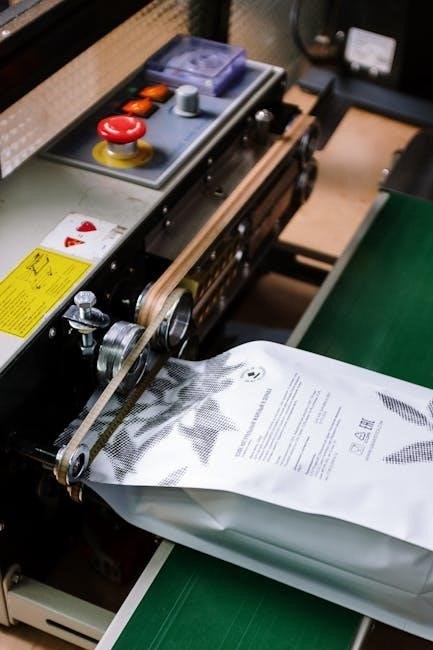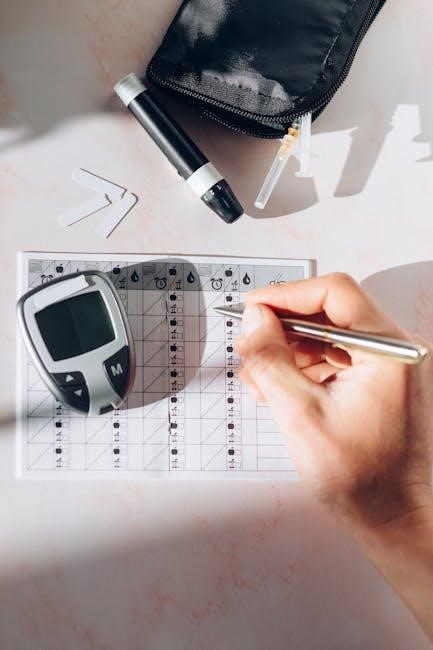Understanding the “Check Coolant Level” Warning
The “Check Coolant Level” warning indicates your vehicle’s computer detects a potential issue with the coolant system, often due to low coolant levels, especially during cold starts.

What the Message Means
The “Check Coolant Level” message signals that your vehicle’s coolant level is potentially low or there’s a system issue. It alerts you to inspect and maintain the coolant to prevent engine damage.
Importance of Coolant in Vehicle Maintenance

Coolant is essential for maintaining your vehicle’s engine temperature, preventing overheating, and protecting against corrosion. It ensures the engine operates within a safe temperature range, preventing damage. Proper coolant levels are crucial for the longevity and performance of your car. Always use the recommended type and follow guidelines in your operator’s manual for optimal maintenance.
Causes of the “Check Coolant Level” Alert
The alert may result from low coolant levels, sensor malfunctions, or leaks in the cooling system. Addressing these issues promptly prevents engine damage.
Low Coolant Level in the Reservoir
A low coolant level in the reservoir is a common cause of the warning. When the engine is cold, the coolant level should be between the MIN and MAX marks on the reservoir. If it’s below the MIN mark, add a mixture of distilled water and antifreeze as recommended in the operator’s manual. Always check the level on a level surface with the engine cool to ensure accuracy. Neglecting this can lead to engine overheating and potential damage. Regular inspections and timely refills are essential for maintaining proper coolant levels and preventing system-related issues. Ensure the reservoir cap is securely tightened after refilling to maintain system pressure. Never overfill, as this can also cause system malfunctions. If the level consistently drops, it may indicate a leak in the cooling system, requiring professional inspection. Always refer to the operator’s manual for specific guidelines on coolant type and refilling procedures. Proper maintenance helps extend the lifespan of your vehicle’s engine and cooling system. By addressing low coolant levels promptly, you can avoid costly repairs and keep your vehicle running smoothly. Regular monitoring of the coolant reservoir ensures optimal engine performance and prevents unexpected breakdowns. Stay proactive with routine checks to maintain your vehicle’s health.
Coolant Level Sensor Malfunction
A faulty coolant level sensor can trigger the warning, even if the coolant level is adequate. The sensor monitors the coolant level and sends signals to the dashboard. If it malfunctions, it may misinterpret the level, causing false alerts. Symptoms include intermittent warnings, especially when driving uphill or on uneven surfaces, as the sensor’s readings may fluctuate. Always visually inspect the coolant reservoir to confirm the level. If the warning persists despite proper coolant levels, the sensor may need replacement. Consult the operator’s manual for specific guidelines on diagnosing sensor issues. Persistent problems should be addressed by a professional mechanic to ensure accurate system functionality and prevent further complications. Regular maintenance and sensor checks can help prevent such malfunctions and ensure reliable performance. Prompt attention to sensor-related issues is crucial for maintaining your vehicle’s overall health and efficiency.
Cooling System Leaks
Cooling system leaks can cause the coolant level to drop, triggering the warning. Leaks often occur in hoses, radiators, water pumps, or the reservoir. Inspect for visible signs of leakage, such as puddles under the vehicle or coolant droplets. A sweet odor or white smoke from the engine may also indicate a leak. If suspected, check the system thoroughly and consult the operator’s manual for repair guidelines. Addressing leaks promptly prevents overheating and damage.

How to Check the Coolant Level Properly
Locate the coolant reservoir under the hood. Check the level when the engine is cold, ensuring it’s between the MIN and MAX marks. Consult the operator’s manual for specific guidelines properly.
Precautions Before Checking
Ensure the vehicle is on a level surface and the engine is cool to avoid inaccurate readings. Turn the ignition to position 2 (or press the Start/Stop button twice for KEYLESS-GO) without starting the engine. Check the coolant temperature display in the instrument cluster; it must be below 158°F (70°C). Never remove the coolant reservoir cap when the engine is hot, as this can cause scalding. Use a rag to slowly loosen the cap, allowing pressure to escape safely. Avoid spilling antifreeze on hot engine parts, as it may ignite. Always refer to the operator’s manual for specific instructions.
Steps to Locate and Inspect the Coolant Reservoir
Open the hood and locate the coolant reservoir, typically labeled with a coolant symbol or marked “Coolant.” Ensure the vehicle is on a level surface and the engine is cold. Visually inspect the reservoir for cracks or leaks. Check the coolant level against the min and max marks on the side. If the level is below the min mark when cold, or above max when warm, further action is needed. Always refer to the operator’s manual for precise location and inspection guidelines specific to your vehicle model.
Understanding Coolant Level Indicators
Coolant level indicators vary by vehicle model but typically include markers on the reservoir showing minimum and maximum levels. When cold, the coolant level should be at the base marker, rising slightly when warm. Some vehicles use electronic sensors to detect low levels, triggering dashboard warnings. Always consult the operator’s manual for specific guidelines on interpreting these indicators accurately for your vehicle. Proper monitoring ensures optimal engine performance and prevents overheating risks.
When and How to Top Up the Coolant
Top up coolant when levels are below the minimum mark. Use a Mercedes-Benz-approved coolant mixture, ensuring it’s diluted correctly to avoid damaging the system. Always refer to the operator’s manual for specific instructions. Add coolant slowly, avoid overfilling, and replace the cap securely. If unsure, consult a professional to prevent further issues. This ensures optimal engine performance and longevity.
Recommended Coolant Type for Your Vehicle
Use a Mercedes-Benz-approved coolant, typically a 50/50 mixture of antifreeze and distilled water. Ensure the coolant meets the specifications outlined in your operator’s manual. Pre-mixed coolants are ideal to avoid incorrect dilution. Avoid using pure antifreeze or excessive water, as this can damage the cooling system. Always refer to the manual for the correct coolant type to maintain optimal performance and prevent corrosion. This ensures longevity and efficiency of your vehicle’s engine.
Safe Procedure for Adding Coolant
Park the vehicle on a level surface and ensure the engine is cool. Open the hood and locate the coolant reservoir. Use a 50/50 mixture of antifreeze and distilled water or pre-mixed coolant. Slowly pour the coolant into the reservoir until it reaches the MAX mark. Avoid overfilling. Replace the cap securely to maintain system pressure. Always refer to the operator’s manual for specific guidelines to ensure safety and prevent damage to the cooling system.
Signs That More Coolant is Needed
The dashboard warning “Check Coolant Level” is the most common indicator. Low coolant levels when the engine is cold may trigger this message, especially in freezing temperatures. The coolant temperature display in the instrument cluster may also show elevated readings. If the coolant reservoir level is below the MIN mark or near the sensor level, more coolant is required. Always refer to the operator’s manual for the correct coolant type and mixing instructions to avoid system damage.

Role of the Operator’s Manual
The operator’s manual provides essential guidelines for checking coolant levels, recommending the correct coolant type, and outlining safe procedures for topping up. It ensures proper maintenance.
Key Information Found in the Manual
The manual provides detailed instructions for checking coolant levels, including when the engine is cold and how to interpret the coolant temperature display. It specifies the correct coolant type and mixture ratio, ensuring optimal performance. The manual also outlines safe procedures for topping up coolant, such as releasing pressure before opening the reservoir and avoiding overfilling. It emphasizes the importance of maintaining the recommended coolant level for proper engine function.
Specific Guidelines for Your Vehicle Model
Your vehicle’s manual provides model-specific instructions for checking coolant levels, such as ensuring the car is on a level surface and the engine is cold. It outlines how to use the instrument cluster to monitor coolant temperature and explains the correct coolant type and mixture for your model. The manual also details safe procedures for topping up coolant, such as releasing pressure before opening the reservoir and avoiding overfilling. Always consult your manual for precise guidance tailored to your vehicle.
Troubleshooting the Coolant Level Warning
Check the coolant reservoir level, ensure it’s within the recommended range, and verify the coolant type matches your vehicle’s specifications. Consult the operator’s manual for reset procedures and additional guidance if the warning persists after addressing the issue.
Resetting the Warning Message
After addressing the coolant issue, the warning message can typically be reset by turning the ignition to position 2, allowing the system to recognize the corrected coolant level. Start the engine, let it run briefly, and check the instrument cluster to ensure the message has cleared. If the issue persists, consult the operator’s manual for specific reset procedures or visit a certified technician.
Checking for Other Related Issues
After addressing the coolant level, inspect for leaks, damaged hoses, or malfunctioning sensors. Ensure the coolant reservoir cap is secure to maintain proper pressure; Check the coolant temperature display and verify it’s within the safe range. If issues persist, test the coolant’s condition and top it up as needed to prevent engine damage. Always refer to the operator’s manual for specific guidance tailored to your vehicle model.

Common Mistakes to Avoid
Overfilling the coolant reservoir, using the wrong coolant type, and ignoring persistent warnings can lead to engine damage or system malfunctions. Always follow manual guidelines.
Overfilling the Coolant Reservoir
Overfilling the coolant reservoir can lead to increased pressure in the cooling system, causing fluid to leak out or potentially damaging the radiator. Always fill coolant between the MIN and MAX marks on the reservoir when the engine is cold. Exceeding the recommended level can push coolant into areas it shouldn’t go, risking engine damage. Ensure proper levels to maintain system functionality and avoid costly repairs.
Using the Wrong Type of Coolant
Using the incorrect coolant type can damage your vehicle’s cooling system. Always refer to the operator’s manual for the recommended coolant specification. Mixing incompatible coolants or using pure antifreeze without water can corrode system components, reduce cooling efficiency, and potentially cause engine damage. Ensure you use the correct pre-mixed or concentrated coolant as specified to maintain optimal performance and prevent costly repairs.
Ignoring Persistent Warnings
Ignoring the “Check Coolant Level” warning can lead to severe engine damage. Persistent warnings may indicate a malfunctioning sensor or a coolant leak. Failing to address these issues can cause overheating, cylinder head damage, or even engine failure. Always investigate the cause promptly and take corrective action to ensure your vehicle’s cooling system operates efficiently and safely.

Knowing When to Seek Professional Help
Consult a professional if the coolant level warning persists despite topping up, or if you notice significant coolant loss, repeated alerts, or suspected system damage.
Signs of a More Serious Coolant System Problem
Persistent coolant warnings despite topping up, visible leaks, or a significant drop in coolant level indicate a deeper issue. Temperature fluctuations, repeated alerts, or engine overheating suggest sensor malfunctions or system breaches. If the problem persists after DIY fixes, it may signal a need for professional inspection to address potential damage to the cooling system or related components.
When DIY Solutions Are Not Enough
If coolant warnings persist despite proper checks and refills, underlying issues like sensor faults or internal leaks may exist. Advanced diagnostics or repairs, such as replacing faulty sensors or fixing system breaches, often require specialized tools and expertise. In such cases, consulting a professional mechanic ensures accurate diagnosis and effective resolution, preventing further damage to the engine or cooling system components.
